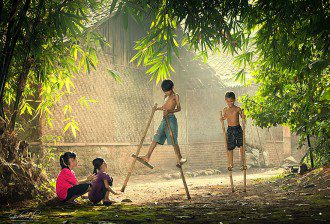Contributing writer for Wake Up World
“We are never more fully alive, more completely ourselves, or more deeply engrossed in anything than when we are playing.” ~ Charles Schaefer
Every generation since the 1950s has experienced a decline in free play. During the holidays in my parent’s generation, kids left the house in the morning and were told to be home by dinner. They went out into the streets, met up with other neighbourhood kids and played all day long. During my own childhood things were a little more supervised, but we still had ample time to play beyond the watchful eyes of our parents.
Today most children are rarely left to their own devices. In an attempt keep our kids safe and provide them with all they need to ensure they have every chance for a happy, successful life, we fill up their days with activities, structured opportunities to learn and seductive screen time. However, as well meaning as this approach might be, there is increasing evidence that it may be doing more harm than good.
[pro_ad_display_adzone id=”110028″]
Mental health issues including anxiety, depression, suicide and narcissism among teens has reached epidemic levels and new research suggests this may be related to a steep decline in free, spontaneous play in childhood. For most of human evolution, children learned through autonomous, self-directed play. Parents weren’t involved in every aspect of their daily lives. Kids played in groups, invented games, made up rules, negotiated, experimented and explored their world with minimal parental interference.
According to Peter Gray, the author of ‘The Decline of Play and the Rise of Psychopathology in Children and Adolescents’:
“Play functions as the major means by which children (1) develop intrinsic interests and competencies; (2) learn how to make decisions, solve problems, exert self-control, and follow rules; (3) learn to regulate their emotions; (4) make friends and learn to get along with others as equals; and (5) experience joy. Through all of these effects, play promotes mental health.”
In an international survey on play sponsored by the IKEA Corporation, 69 percent of the children sampled in the United States (and 58 percent of those in the entire international sample) stated that outdoors was their preferred place to play. However the same study found that parents often restricted outdoor play.
The reason most frequently given (by 49% of parents) for limiting outdoor play was, “They may be in danger of child predators”. I think we all feel terror in our hearts when we hear about children who are abducted and naturally want to protect our children from such a horrific fate. However, according to Gray, levels of child abduction are low and have actually declined over the last decades. As well, disturbingly, most abuse is perpetrated by people close to the children, and not by strangers. Gray suggests the media might be responsible for the increased levels of fear around this issue, and that we may be going too far in our attempts to protect our children.
Screen time is of course another major factor in the decline of free, self-directed play. With so many educational shows and interactive games, many parents have embraced technology as a means to keep their children safely entertained and engaged. Children are naturally drawn to these forms of entertainment as they provide easy stimulation. However, several studies have shown that excess screen time has the ability to detrimentally affect children’s brain development. According to Victoria L. Dunckley, M.D, an integrative child, adolescent and adult psychiatrist, and an expert on the effects of screen-time on the developing nervous system:
“Much of the damage occurs in the brain’s frontal lobe, which undergoes massive changes from puberty until the mid-twenties. Frontal lobe development, in turn, largely determines success in every area of life — from sense of well-being to academic or career success to relationship skills.”
Another significant factor in the decline of free play is our desire to provide our children with opportunities to develop a variety of skills. Some children spend the whole day in class, then have enough extra-curricular activities like music lessons, soccer and second language tutoring to ensure that every minute is used ‘productivity’. These high powered schedules are often taxing not just to the children, but to the parents as well as a lot of time and energy are required to meet these demands. Even so, a lot of parents are willing to put up with these sacrifices because they feel that they are offering their children opportunities that will provide them with an advantage and contribute towards their future success.
“Humanity has advanced, when it has advanced, not because it has been sober, responsible, and cautious, but because it has been playful, rebellious, and immature.” ~ Tom Robbins
Increasingly child development experts are suggesting that too much emphasis on structured activities could result in negative rather positive outcomes for children. Children who are always busy have little time to get in touch with their inner selves. Most of us have learned to perceive boredom negatively, but we are now beginning to understand the value of boredom. Boredom can act as a catalyst to provoke the generation of imaginative ideas, self-exploration and can push kids to dig deep and discover their own areas of interest.
 I believe this trend away from free play, and the resulting developmental issues, also reflects a deeper social problem: a disconnection from our deeper levels of being. Beneath the layers of social programming we all contain a deep, magical, mysterious part of ourselves. When we feel connected to that deep part we feel more whole and centred, and life feels more alive and meaningful. But today’s society is driven by consumerism, and in order to perform well and fit into an economically driven world, we are pushed into socially constructed moulds that value productivity and appearances over depth and authenticity.
I believe this trend away from free play, and the resulting developmental issues, also reflects a deeper social problem: a disconnection from our deeper levels of being. Beneath the layers of social programming we all contain a deep, magical, mysterious part of ourselves. When we feel connected to that deep part we feel more whole and centred, and life feels more alive and meaningful. But today’s society is driven by consumerism, and in order to perform well and fit into an economically driven world, we are pushed into socially constructed moulds that value productivity and appearances over depth and authenticity.
One of the most potent tools we have to help us connect with the inspiration and ingenuity of these deeper levels is imagination. Imagination is a faculty that brings children’s play alive; it allows them to animate and explore both their inner and outer worlds. When children’s opportunities for engagement primarily include only externally directed activities, imagination, the gateway to the deeper self, is stifled and disconnection is encouraged.
When we consider all the ways that free, self-directed play provides children with opportunities to explore, experiment and develop important skills for successfully interacting with both their inner and outer worlds, and how it is likely an important key in preventing and reducing levels of adolescent mental health issues, it seems clear that our children would benefit from more time to play without adult interference. Of course we don’t have to try and recreate the fifties. The world has changed since those times and what worked then might not be suitable for today. But that doesn’t mean that we can’t provide safe opportunities that encourage children to have more autonomy and self-direction in their style of play. In fact, in a world that puts so much pressure on people to be serious and productive, we might all benefit from a bit more non-goal oriented play. We are taught to see play as something that should be left behind in childhood, but being able to not take ourselves too seriously, to be able to be frivolous and silly at times, undoubtedly contributes to a healthy and balanced lifestyle.
“Men do not quit playing because they grow old; they grow old because they quit playing.” ~ Oliver Wendell Holmes Sr.
References:
- www.journalofplay.org/sites/www.journalofplay.org/files/pdf-articles/3-4-article-gray-decline-of-play.pdf
- www.forbes.com/sites/robasghar/2014/02/20/all-work-and-no-play-makes-your-child-a-narcissist/#686ce6d638b2
- www.psychologytoday.com/blog/freedom-learn/201001/the-decline-play-and-rise-in-childrens-mental-disorders
- www.psychologytoday.com/blog/mental-wealth/201402/gray-matters-too-much-screen-time-damages-the-brain
About the author:
Christina Lavers is a writer, an artist, a creative enthusiast, and an inner world explorer. Born in Montreal Quebec, Canada, she now lives with her life partner and son in a rainforest pocket in the hills behind Coffs Harbour, NSW Australia. She spends her time playing, creating, growing and sharing.
Christina is devoted to assisting people to find and connect with their own creative magical current that flows deep within. She is now offering a comprehensive e-course designed to help people light up their world with passion and creativity. You can access Section One here for free!
Christina has also recently published her first full length book, a memoir about her wild awakening journey entitled Jump Into the Blue, and she is currently working on the next one.
“My journey has been about personal alchemy… exploring the mysteries of my soul and my environment, and learning to bring all aspects, the light and the dark, together with the transcending ingredient… love. The more I uncover and nurture the wounded aspects of my being, the more whole and grounded I feel and the more my outer world reflects the love, wonder and magic I have discovered inside”.
You can follow Christina’s work at:
Recommended reading by Christina Lavers:
- Are You a Bridge Between Two Worlds?
- Addictive Behavior Related to Low Levels of Oxytocin, the “Love/Bonding Hormone”
- 10 Signs You’ve Bought Spin
- New Study Shows Regular Contact with Nature Reduces Crime, Increases Social Cohesion
- Sugar is as Addictive as Cocaine – Here’s How You Can Kick the Habit
- Research Shows Just 7 Minutes of Meditation Can Reduce Racial Prejudice
- Taking Care of Our Inner Tribes – Microflora, Awakening and You
- Groundbreaking Study Maps the Decline of Wild Bee Communities in the United States
- Taking Responsibility For Our Energy
- More Evidence That TV is Dumbing Us Down
- Synchrony and Exertion of Dancing Found to Encourage Social Bonding, Raise Pain Threshold
- Quitting Smoking? Try These Herbs, Tips and Incentives to Help You Succeed!
[pro_ad_display_adzone id=”110027″]










